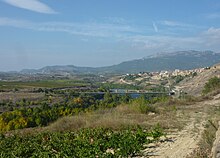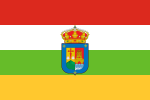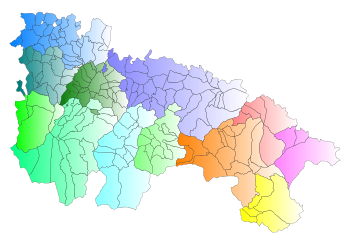La Rioja (Spanish region)
|
La Rioja ( Spanish ) La Rioja |
|||||
|---|---|---|---|---|---|
|
|||||
| Basic data | |||||
| Country : |
|
||||
| Capital : | Logroño | ||||
| Area : | 5,045 km² | ||||
| Residents : | 316,798 (January 1, 2019) | ||||
| Population density : | 62.8 inhabitants / km² | ||||
| Expansion: | North – South: approx. 50 km West – East: approx. 100 km |
||||
| ISO 3166-2 : | ES-RI | ||||
| Website : | larioja.org | ||||
| Politics and administration | |||||
| Autonomy since: | June 9, 1982 | ||||
| President : | José Ignacio Ceniceros González ( PP ) | ||||
| Representation in the Cortes Generales : |
Congress : 9 seats Senate : 2 seats |
||||
| Structure : | The autonomous community consists of a single province . |
||||
| map | |||||

La Rioja [ la'rjoxa ] is a province and autonomous community in northern Spain with the capital Logroño . Other cities and towns in this region, known for its wine , the Rioja , are Calahorra , Arnedo , Haro , San Asensio and Nájera . La Rioja covers an area of 5045.25 km²; the population is 316,798 (as of January 1, 2019). The autonomous community has its own parliament, the Parlamento de La Rioja .
Word origin
The word Rioja is probably a combination of "Río-Oja", meaning " Oja river ", which flows through the La Rioja region into the Ebro . Other opinions associate the word with derivatives from the Basque language .
geography
The Rioja borders on the autonomous communities of Castile-León and Aragon to the west, south and east and on the Basque Country and Navarre to the north ; the northern border of the Rioja region is roughly identical to the course of the Ebro .
Several rivers flow into the fertile Ebro Basin from the south, ie from the Iberian Mountains at a maximum height of 2271 m : Río Tirón , Río Najerilla , Río Iregua , Río Leza , Río Cidacos and Río Alhama .
The climate is comparatively rainy with a continental influence by Spanish standards, warm in summer and cool in winter.
history
At the time of the Roman Empire , the Rioja was populated in the north and west by Vaskonen and in the south and east by Celtic tribes ( Beronen and Pelendonen ).
In the Visigothic Empire , most of the Rioja belonged to the Duchy of Cantabria, a border march to defend against Cantabrians and Vaskons. After the fall of the Visigoth Empire in the 8th century, like the entire peninsula, it initially belonged to the Moorish-ruled area , but before the turn of the millennium came under the influence of the Christian kingdom of Asturias, which rebelled against Islamic rule .
From the 10th century onwards, Navarre and Castile vied for supremacy in the region. During these confrontations, Alfonso VII of Castile and Sancho VI met. of Navarre in 1176 an agreement in which it was determined that from 1177 Navarre had to cede the western part of the Rioja to Castile.
From the creation of the provincial administrative system by the Spanish Bourbons until the 19th century, the area of the Rioja was divided between the Spanish provinces of Soria and Burgos . The province of Logroño was created in 1833 as part of the administrative reform of Rafael del Riego . After the end of the Franco dictatorship , the name of the province was officially changed to La Rioja in 1980 . Since 1982 La Rioja has been an autonomous community with its own statute of autonomy within the entire Spanish state. The creation of the smallest autonomy in terms of inhabitants and, together with the Balearic Islands, also in terms of area in the course of the transition in Spain had historical-political reasons related to the consideration of the balance of interests between the Basque independence movement and the Castilian-dominated Spanish central state.
Population development of the province

economy
In 2015 the GDP of the Rioja was 7,890,000,000 euros. Around half of GDP is in the service sector and a quarter in the industrial sector. The most important branch of industry is the food and beverage industry, ahead of the metal and textile industries.
Large parts of the D.OC Rioja wine-growing region , which is one of the most important in Europe, are located in the La Rioja region ; see the main article Rioja (wine) . The region is therefore involved in the Instituto de Ciencias de la Vid y del Vino .
In addition to viticulture, there are also important vegetable growing areas in the Rioja in the Ebro Basin . Mainly mushrooms , artichokes , asparagus and peppers are cultivated.
In comparison with the GDP per capita in the EU , expressed in purchasing power standards, La Rioja achieved an index of 98 (EU-27: 100, as of 2015). In 2017 the unemployment rate was 12%.
With a value of 0.899, La Rioja ranks 4th among the 17 autonomous communities in Spain in the Human Development Index .
Largest communities
As of January 1, 2019
| local community | Residents |
|---|---|
| Logroño | 151.136 |
| Calahorra | 24,220 |
| Arnedo | 14,875 |
| Haro | 11,408 |
| Alfaro | 9,476 |
| Lardero | 10,500 |
| Nájera | 8,045 |
| Villamediana de Iregua | 8,070 |
| Santo Domingo de la Calzada | 6.238 |
| Autol | 4,512 |
Sub-regions and comarcas
The autonomous region of La Rioja is divided into three sub-regions. Rioja Alta, Rioja Media and Rioja Baja, which are further subdivided into 13 administrative units (comarcas) as follows:
|
Sub-regions of La Rioja |
Sierra (mountain region) |
Valle (valley region) |
| Rioja Alta |
Comarca de Anguiano Comarca de Ezcaray |
Comarca de Haro Comarca de Santo Domingo de la Calzada Comarca de Nájera |
| Rioja Media |
Tierra de Cameros |
Comarca de Logroño |
| Rioja Baja | Comarca de Cervera |
Comarca de Alfaro Comarca de Arnedo Comarca de Calahorra |
Web links
Individual evidence
- ↑ Cifras oficiales de población resultantes de la revisión del Padrón municipal a 1 de enero . Population statistics from the Instituto Nacional de Estadística (population update).
- ^ Henrike Knörr: Guillermo Rittwagen.
- ↑ Luis Vicente Elías Pastor: Revista de Folklore. Fundación Joaquín Díaz 1990 / 10a / 114.
- ↑ Datos de Economía . Instituto de Estadística de La Rioja.
- ↑ Eurostat. Retrieved April 15, 2018 .
- ↑ Unemployment rate, by NUTS 2 regions. Retrieved November 5, 2018 .
- ^ Sub-national HDI - Area Database - Global Data Lab. Retrieved August 12, 2018 .
Coordinates: 42 ° 17 ′ N , 2 ° 28 ′ W






